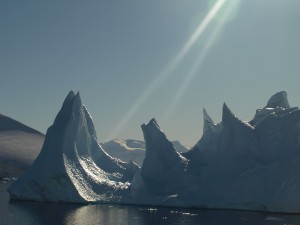Devotees would often come to Sri Ramakrishna to discuss about spiritual matters. One of the topics often discussed was the difference between jnana and bhakti i.e. knowledge and devotion. Devotees would often find it extremely difficult to reconcile these two apparently divergent views of reality.

Melting Iceberg in sunshine
Sri Ramakrishna had a unique way of reconciling both the views. He would say that both are essentially the same and are needed for people of different mindsets. He would compare knowledge to flowing water and devotion to ice. While water has no form, ice has a clear form. But, in essence both are one and the same substance. The devotees when they pray intensely to God or Ultimate Reality, the cool breeze of devotion helps the manifestation of God in a form that is adorable and which is capable of satisfying the emotional demands of the devotees. He would say that the cool breeze blowing over large tracts of water helps in the formation of ice at different places on the surface. Again when the sun rises, the heat produced melts the ice and once again it becomes water. Thus knowledge and devotion are essentially one and the same and they represent two phases or two aspects of the same reality such as water and ice.
Human beings are endowed with various types of minds. For a large number of people the form or symbol is something to hold on to and is extremely essential to progress in the path of spirituality. Hence, name and form are of great benefit, rather they are essential for such devotees. Some others are endowed with a mind capable of razor-sharp reasoning. For them the formless aspect of reality is more soothing or acceptable. They don’t need any name or form for the purpose of their sadhana.
Thus essentially both the approaches to the Ultimate Reality are equally valid. But what is really important is to choose a path suitable to oneself and delve deep into sadhana.
-by Swami Shantatmananda, Sunday Guardian, 24th Jan 2015
(Image courtesy of University of Cambridge Department of Engineering and Nokia)
